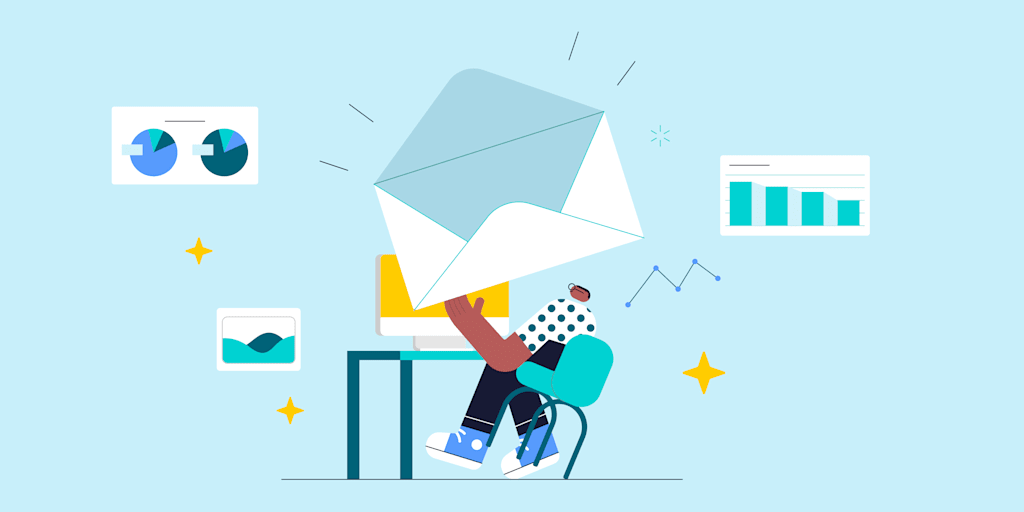When it comes to return on investment (ROI), email marketing leads the way with a whopping $36 for every $1 spent.
That success rate boils down to three crucial factors: segmentation, personalization, and automation. When executed correctly, you can segment your leads to send relevant, personalized, and automated email sequences that are highly effective.
In this guide, we’ll dive into the benefits of email sequences, 8 types of email sequences, and tips for creating an effective email sequence. We’ll also show you how to use the monday CRM sequences feature to create automated email sequences that deliver results, with ease.
What is an email sequence?
An email sequence is a series of emails automatically sent to a lead, prospect, or customer on a set schedule using automation software. Each email sequence has a different pre-defined objective, which can range from nurturing leads to engaging current customers.
Email sequences are triggered by predefined, specific criteria, which creates an extra element of personalization in your email marketing strategy.
This predefined criteria is generally based on specific customer behavior and could include things like:
- Browsing your website
- Signing up for a free trial
- Downloading an ebook
- aAbandoning their cart
Each of these actions would act as a trigger that leads to an automated, pre-scheduled, and personalized email sequence with specific relevance to the action a user took. For example, let’s say somebody pressed a button to download an ebook about productivity on your website. This trigger would send out an email sequence over the course of 2 weeks that starts by giving the user more information about productivity tips and eventually incentives them to buy your product to help them boost productivity.
Triggers within an email sequence can also determine the specific journey the sequence will take. For example, only if someone clicked a specific link within the first ebook email, indicating a high level of interest in your product, would they receive a targeted email containing a special offer. But if they pressed a link indicating they were still unsure about the product, or didn’t open the email to begin with, they would then receive a different targeted email providing more information.
Email sequences can also be triggered at a predetermined time interval. This could include things like:
- 20 days after sign up to a product
- Specific holidays
- Year anniversary of being a customer
Behavior-based email sequences are generally more effective than time-triggered email sequences since they let you personalize why and when you deliver your mass emails, making them more relevant to the person receiving them.
According to the Email Marketing Benchmarks by GetResponse, Automated emails triggered by your customers’ behavior have the highest open rates (35.64%) and click-through rates (5.31%).
Benefits of using email sequences
In today’s competitive market, there’s a reason so many companies implement email sequences as part of their email marketing strategy. Using email sequences can:
Create more personalized customer relationships
A study by McKinsey found that Companies that use personalization in their marketing campaigns make 40% more revenue than the competition. This makes sense because you’re more likely to engage with something that feels uniquely relevant to you. Email sequences are innately personal because they work in direct response to a specific action someone took. Additionally, the journey an email sequence takes is often dependent on customer behavior regarding how they respond to the email. Personalization grabs the recipient’s attention, builds trust, and leads to lasting customer relationships.
Save time
While, in theory, sending hand-written personalized messages to each prospective client sounds like a nice idea, in reality, nobody has time to do that. Email sequences are great because they send personalized emails in bulk. You only need to plan out and write each email sequence once, then determine the criteria for when each email will be sent, and you’re done! With the right automation software with key features, you can preplan these emails and ensure they’re sent at the exact time you’ve outlined.
Provide key analytics & insights
Email sequences can easily be tracked with the right email sequence tool. Email marketing software allows you to track common metrics like email open rates, engagement rates, click-through rates, email conversion rates, customer churn, and customer lifetime value. When properly tracked and analyzed, these metrics and detailed analytics can provide valuable insights into your email marketing efforts that teams can then use to rework their marketing strategy.
8 types of email sequences
Here are 8 email sequences with different purposes, ranging from converting leads to paying customers to re-engaging disinterested customers.
1. Welcome email sequence
The welcome email sequence is the initial sequence of emails someone can expect to receive in their inbox after signing up for a mailing list or for a product/ product trial. This sequence is especially important because it’s one of the first interactions somebody has with your brand: it effectively sets the tone and creates an impression for your business.
Trigger: a sign-up to a product or email list
- Purpose: introduce prospects to your business
- Best practices:
- Use this as an opportunity to set expectations on the type and frequency of emails a customer will receive
- Keep them short/ to the point not to overwhelm new users
2. Onboarding email sequence
You can use customer onboarding email sequences to convert a trial user into a customer or walk new customers through your product. Depending on the situation, the onboarding sequences can vary in length. For example, if a user starts a 14-day trial, you can only run a 2-week sequence. However, for new customers, you might want to condense or extend the time frame depending on the complexity of your product or service.
- Trigger: a user has signed up for your service or product
- Purpose: provide helpful information to trial users or new customers, ensuring they have a positive customer journey experience getting started with a product or service
- Best practices
- Include visuals such as video tutorials, GIF walkthroughs, or tutorial links
- Customize different directions within the email sequence based on a customer’s onboarding progress/ interactions with the onboarding process
3. Lead nurturing email sequence
Lead nurturing aims to show prospects you understand their pain points while educating them about your product. The goal is to build trust and develop a relationship rather than push for a sale. By the end of the nurture sequence, you should be able to move your leads down the sales funnel onto the conversion email sequence.
- Purpose: build trust and develop relationships with potential customers
- Trigger: a potential lead has clicked something indicating interest in your product/ service
- Best practices:
- Share a mix of valuable content like white papers, case studies, and comparison guides to keep prospects engaged
- Be sure the sequence educates rather than sells, as the priority in this sequence is relationship-building through educational content
4. Conversion email sequence
The conversion email sequence is for sales-ready prospects. It’s reserved for leads who have shown a high level of interest in your product or have already opened, engaged, and responded to the lead nurturing series. At this stage, you’re no longer educating or inspiring—you’re asking prospects to take action like booking an appointment, scheduling a demo, or purchasing a product.
- Trigger: the lead has shown a high level of interest (based on a predetermined threshold) in your product or service — could be visiting a social media page, signing up for a demo, or engaging with an initial lead nurturing cold email sequence
- Purpose: get prospects to convert to paying customers
- Best practices
- The CTA should be as clear as possible — make it easy for leads to click the sign-up button
- Make use of personalization as much as possible to make sure the emails don’t feel aggressively sales-y
5. Re-engagement email sequence
It’s natural that some customers will eventually lose interest or forget about your product. They’ll stop opening your emails or quit using a product they signed up for altogether. While focusing on new leads is one strategy, research has shown that re-engaging existing customers is five times cheaper than acquiring new ones. The re-engagement sequence (also known as the win-back sequence) consists of a short series of incentivized emails encouraging disengaged leads and customers to reconnect with your brand.
- Purpose: re-engage inactive email subscribers or customers no longer interacting with your product
- Trigger: acertain (pre-defined) amount of time a customer hasn’t used a product or opened an email
- Best practices:
- Highlight the value of the product/service to remind them what they’re missing out on. Make use of social proof for real examples of the product value or if you are marketing a SAAS product, you can remind them of the specific progress they made while using the product
- Offer a special incentive towards the end of the sequence to ignite a customer’s attention
6. Abandoned cart email sequence
A recent study showed that a striking 70% of shoppers abandon their carts. But the good news for marketers is that shoppers respond well to reminders that they’ve abandoned their cart — research conducted by MailChimp found these types of emails outperform many other types of email marketing sequences with a 39.07% open rate and a 23.33% click-through rate. This email sequence may be very well be the determinative factor of whether a shopper makes their purchase or not.
- Purpose: to get users to return to an abandoned existing cart and check out
- Trigger: user adds items to their cart but doesn’t follow through with their purchase
- Best practices
- Send the initial email in the sequence within the first 24 after a customer has created their cart so they don’t forget about it or move on to a different product
- Make sure everything in the cart is still available for purchase, and provide visuals of the specific products in their cart if possible
7. Subscription renewal email sequence
Renewal email sequences remind existing customers their current subscription or license is about to expire and what actions they need to take before that date. Typically, a renewal email sequence includes an email shortly before the subscription expires, an email on expiration day, and a follow-up email after the membership has expired to encourage users to renew one more time.
- Purpose: get existing customers to renew their subscriptions or license
- Trigger type: a user still hasn’t renewed their subscription a certain (predetermined) number of days before the expiration date
- Best practices:
- Use behavior-based triggers to ensure the sequence stops as soon as a customer renews so they don’t receive irrelevant emails that might annoy them
- Create a sense of urgency through a special offer to renew their service at a desirable price to motivate them to renew ASAP
8. Customer feedback sequence
No feedback is more valuable than that from the customers themselves. That’s why it’s common for companies to send email sequences urging customers to complete a survey or review/share their experiences.
- Purpose: gain feedback to improve the customer experience
- Trigger: a pre-determined amount of time post-purchase or right after a customer service interaction
- Best practices
- Keep surveys as short and easy to access/ fill out as possible
- To increase response rates towards the end of the email sequence, offer an incentive to fill out the survey, such as a reward or discount
Email sequence tips from a monday.com marketing automation expert
We spoke to Arielle Gordis, Senior Marketing Manager of the Lifecycle Marketing Team at monday.com, to gain expert insight on creating effective email sequences. Here are her key tips and best practices for creating email sequences that deliver.
Consistency is key
Email flows are an excellent opportunity to create and enforce a cohesive brand that resonates with your audience. “Try to make sure the email style and tone of voice are consistent across the sequence so it feels more familiar,” said Gordis.
Always offer unique value
“Make sure each email in a sequence brings a unique value — no two emails should be about the same message/ value prop,” exclaimed Gordis
She also adds that each email should lead with immediate value for the recipient, rather than a focus on your company and what you have to offer.
“To give your sequence a personal touch, focus on who they are and what they need rather than who you are and what you want them to do,” she said.
Email flows should be specific, but not overly specific
“It’s definitely important to create targeted flows so that your message really resonates with the right audience, including references to their industry or seniority. But you want to make sure they’re not too specific so that they exclude a particular audience,” said Gorids.
She recommends asking open-ended questions rather than yes-or-no questions, especially in the email subject line or headline.
“You’re putting yourself in danger with yes or no questions because if they answer no, you just lose the audience entirely,” she cautioned.
How to create an effective email sequence
With those tips and best practices in mind, follow these steps to create intentional and successful email sequences.
1. Define your objective
Every email sequence should be carefully crafted with a clear objective, whether to re-engage an existing customer or convert a lead to a sale.
2. Identify clear trigger(s)
Next, you’ll need to clearly identify the trigger that will prompt the email sequence. The trigger should be carefully planned to ensure your sequence reaches the right person at the right time. For example, the trigger for an abandoned cart email will be simple: something like, “email sends once someone abandons their cart longer than 20 minutes.” Automation software can immediately recognize these triggers and ensure an email is sent accordingly.
3. Map out the precise flow of the sequence
You’ll then need to decide how many emails will be in a sequence. What should the length between emails be? Where can you use segmentation within the sequence based on customer behavior to change the trajectory of the emails? Write out all possible scenarios, ensuring a stable flow that leads to your goal.
4. Write out the emails
Next, write out the emails based on the flow you created. Email content should be engaging, and each email should progressively move the audience to the desired action. Personalization here, referencing names or specific user actions, is extremely valuable. Many of the leading project management software like monday CRM, offer email templates to streamline the email creation process.
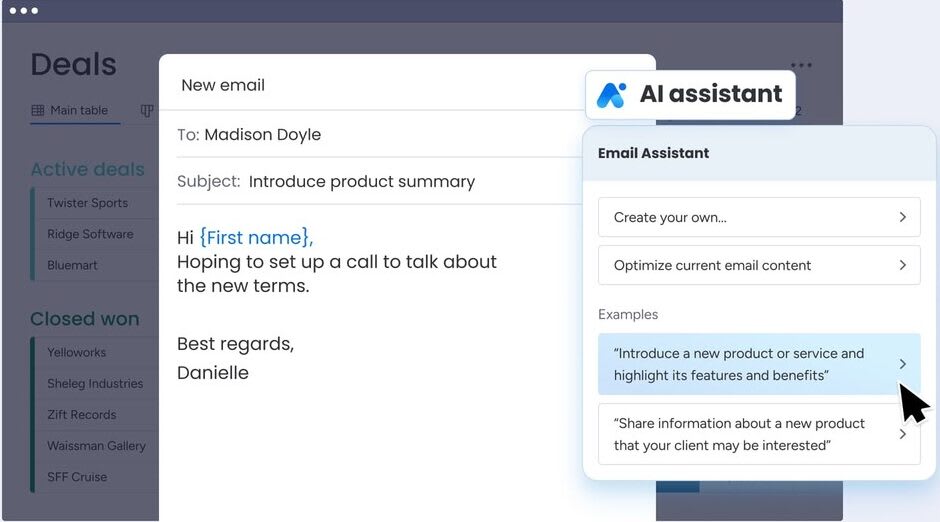
5. Use a software with automations to build out your sequence
Now that you’ve designed a well-thought-out email sequence, it’s time to put it into action. To do this, you’ll need to use robust software with automation capability; this allows you to simply set up your triggers once so emails can be sent out automatically. We recommend monday CRM, as it offers a powerful Sequence feature for you to easily write out your sequences, identify triggers, and track metrics/ outreach efforts in one place.
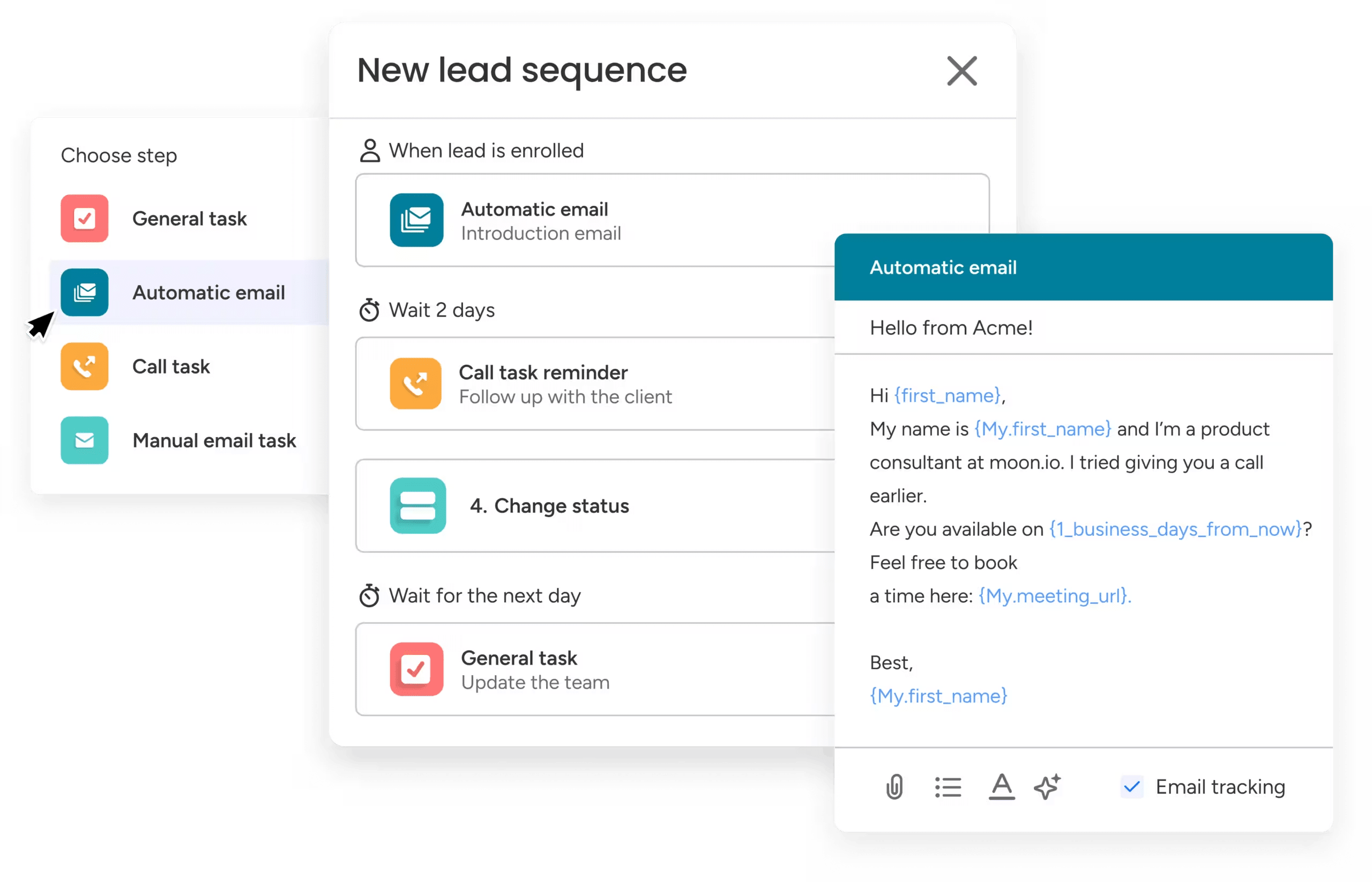
6. Test the sequence
Lastly, you’ll need to test your email sequence to ensure it all works as planned and you are receiving the expected results. This is an excellent time to practice A/B testing with things like subject lines, content, and timings to see what performs best. Software that allows you to track metrics to improve your sequences is a shortcut to success here.
Sequences: the new monday CRM feature to craft effective sequences with ease
Sequences in monday CRM are designed for teams to create, track, and monitor their email sequences easily in one place. This allows you to build an automated customer interaction flow from start to finish. Use dynamic fields to customize content and ensure emails are automatically sent based on the schedule and conditions defined in a sequence.
Here’s a step-by-step guide to using the feature:
1. Open and build out a sequence
Choose the automatic email building block to create your sequence. Map out the steps of the sequence, including delay steps to control the timing between actions, ensuring that steps occur in the desired order and timeframe.
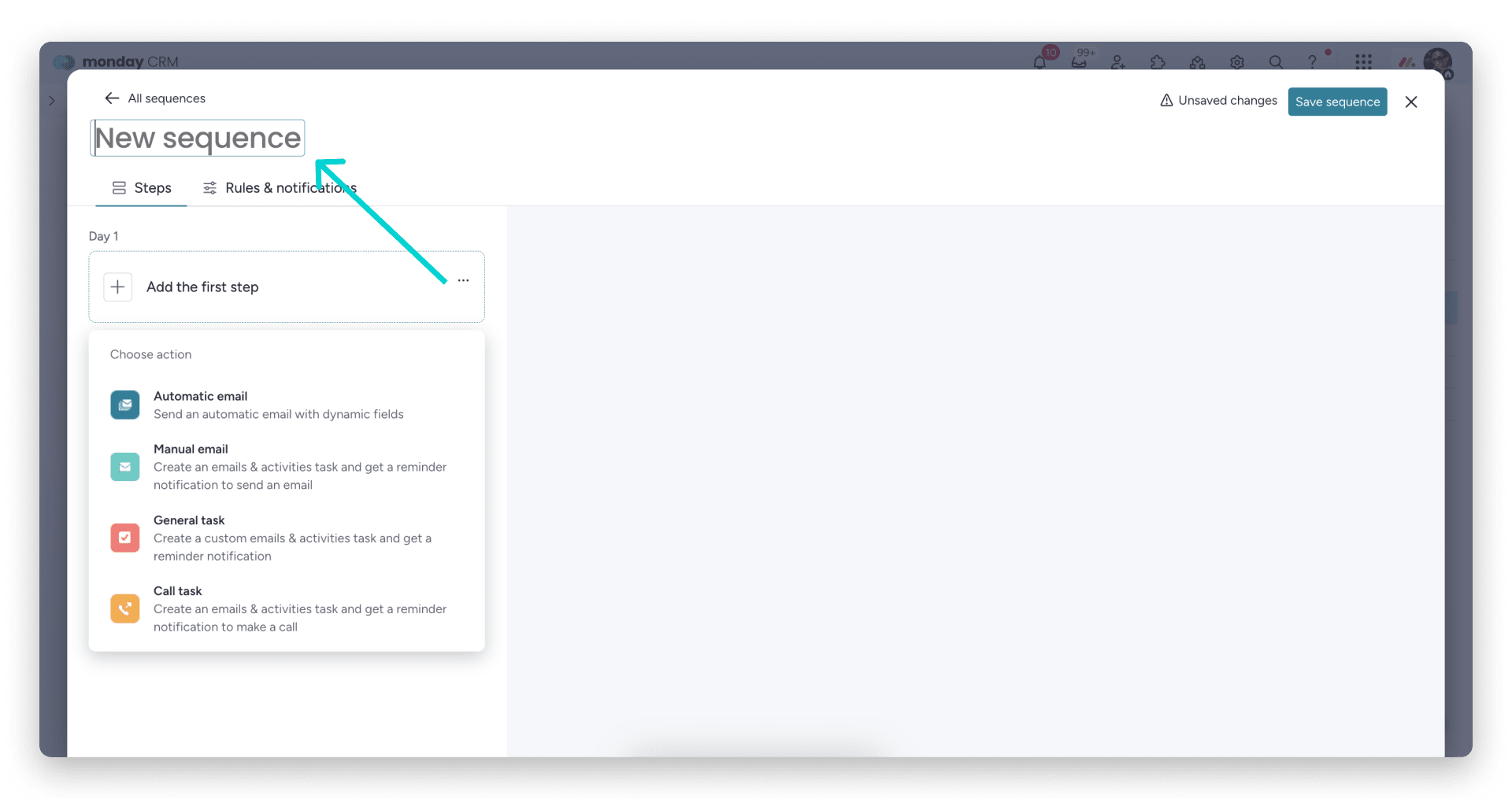
2. Compose the emails
You can set up either manual or automated emails within your sequence. Customize the email as much as you want, using dynamic fields to personalize the email. To insert dynamic fields into your email, use the “{}” symbol. If you choose to use dynamic fields, you can even pull in data from any column on your existing board.
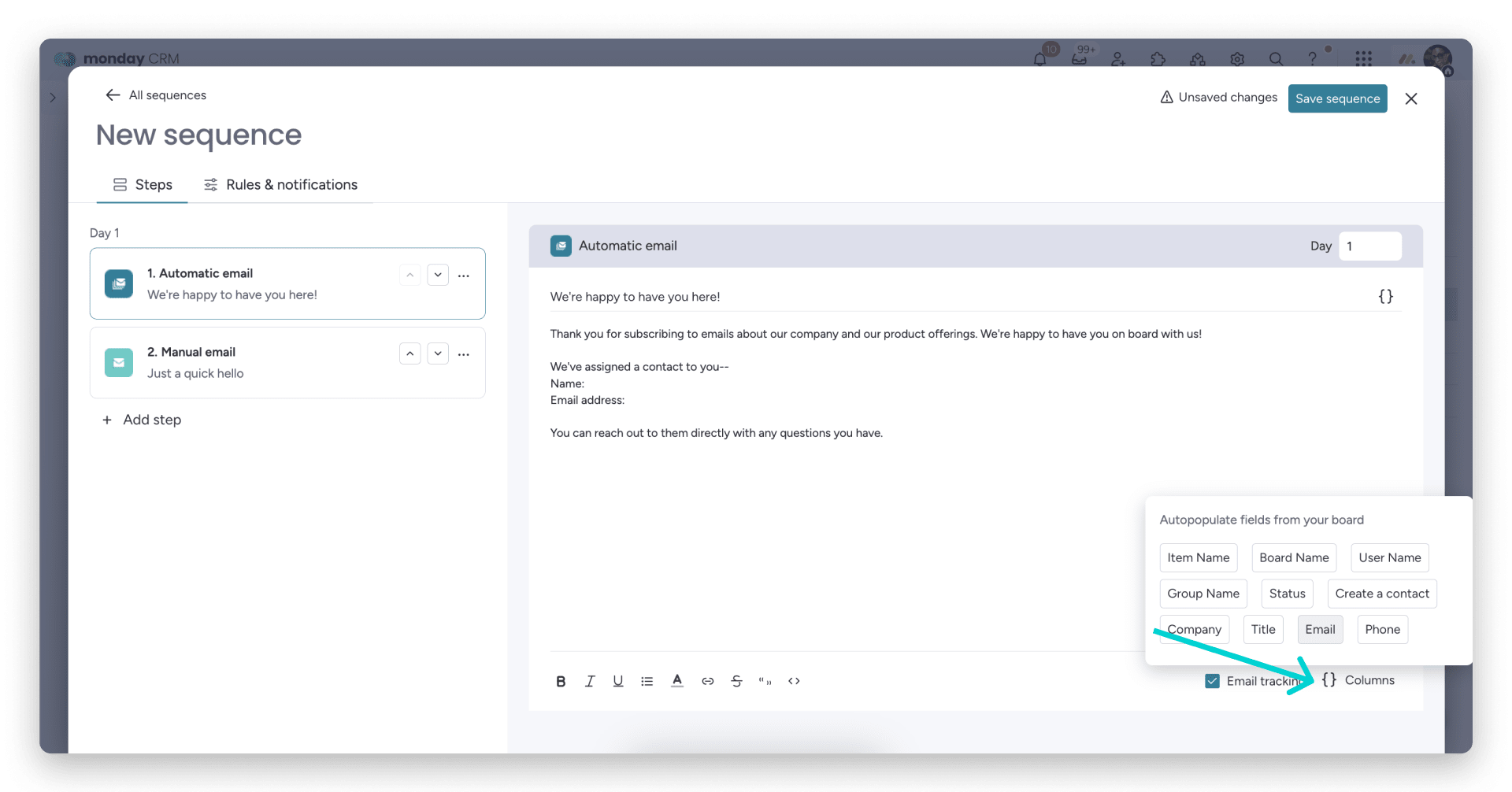
3. Customize the sequence
Use the “Rules & notifications” tab to further customize and configure your sequence.
Use the Sequence data section to establish your sequence’s audience
- Designate which email address the emails in your sequence will be sent from
- Choose the board from which this Sequence will pull data. You’ll likely want to choose the Contacts or Leads board
- Choose which columns on your board to use for pulling in the email address and phone number
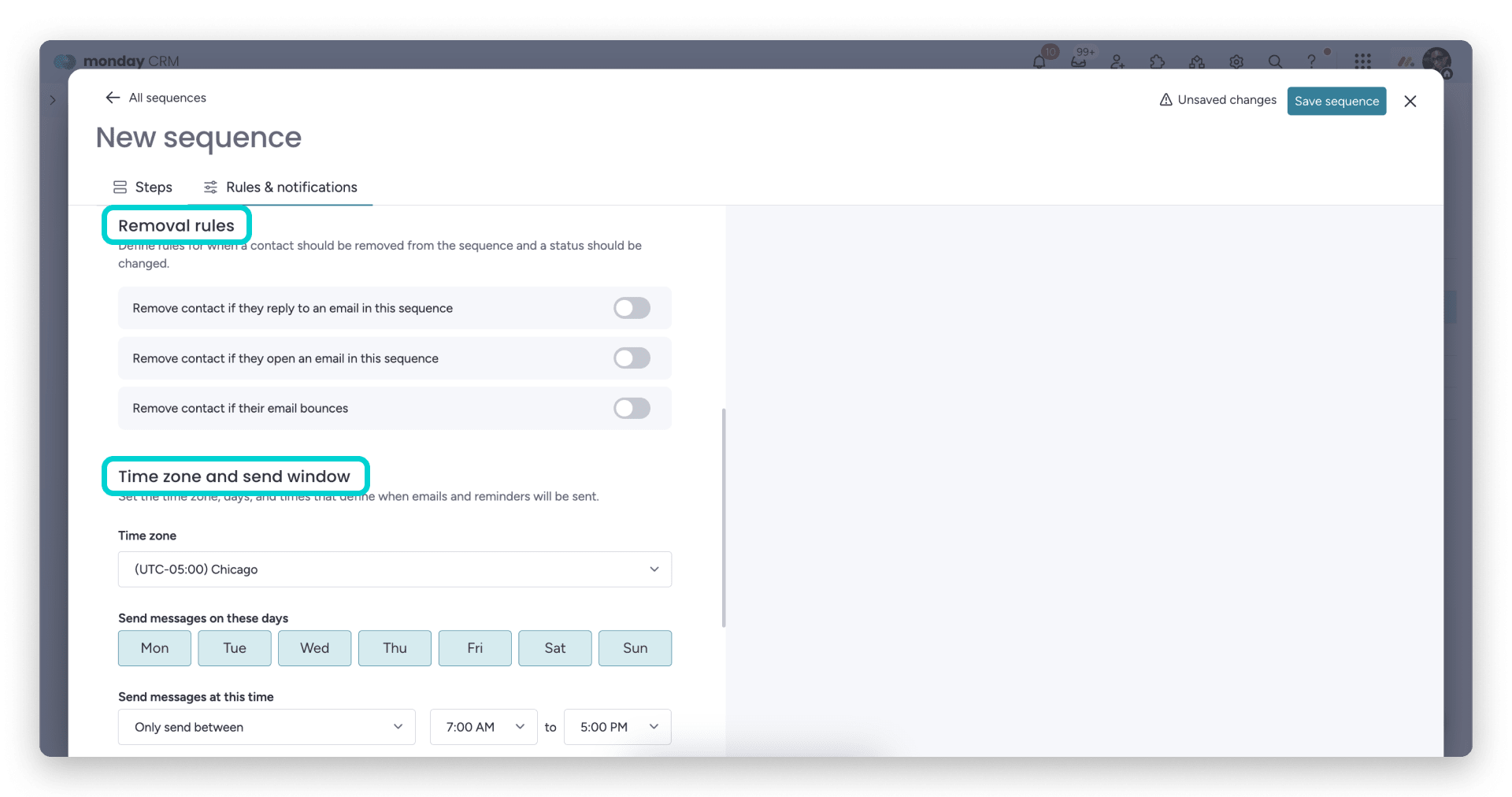
Use the Removal rules section to designate which conditions must be met for a contact or lead to be removed from the Sequence. Options include:
- Remove contact if they reply to an email in this sequence
- Remove contact if they open an email in this sequence
- Remove contact if their email bounce
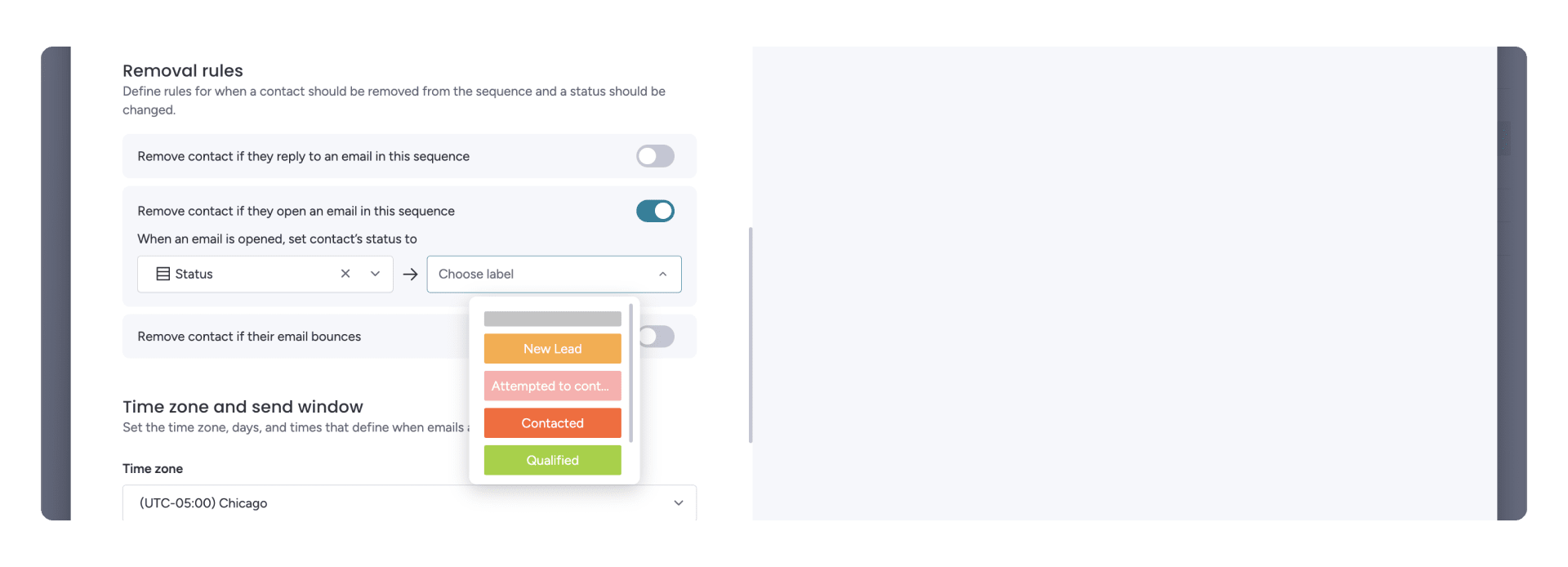
Use the Time zone & send section to customize when your emails are sent.
- Pick the time zone you’ll use for the sequence
- Pick the day of the week you’ll want to send the emails — choose to skip weekends or a specific day of the week to your liking
- Choose the time frame your email will be sent
Use the Notification section to set up automatic notifications that relevant team members will receive based on specific conditions. For example, configure the settings here to
- Receive a notification when a sequence ended due to engagement
- Receive a notification when it’s time to make a call or send another email if you make the decision to do it manually
- Determine exactly which member of your sales team gets notified
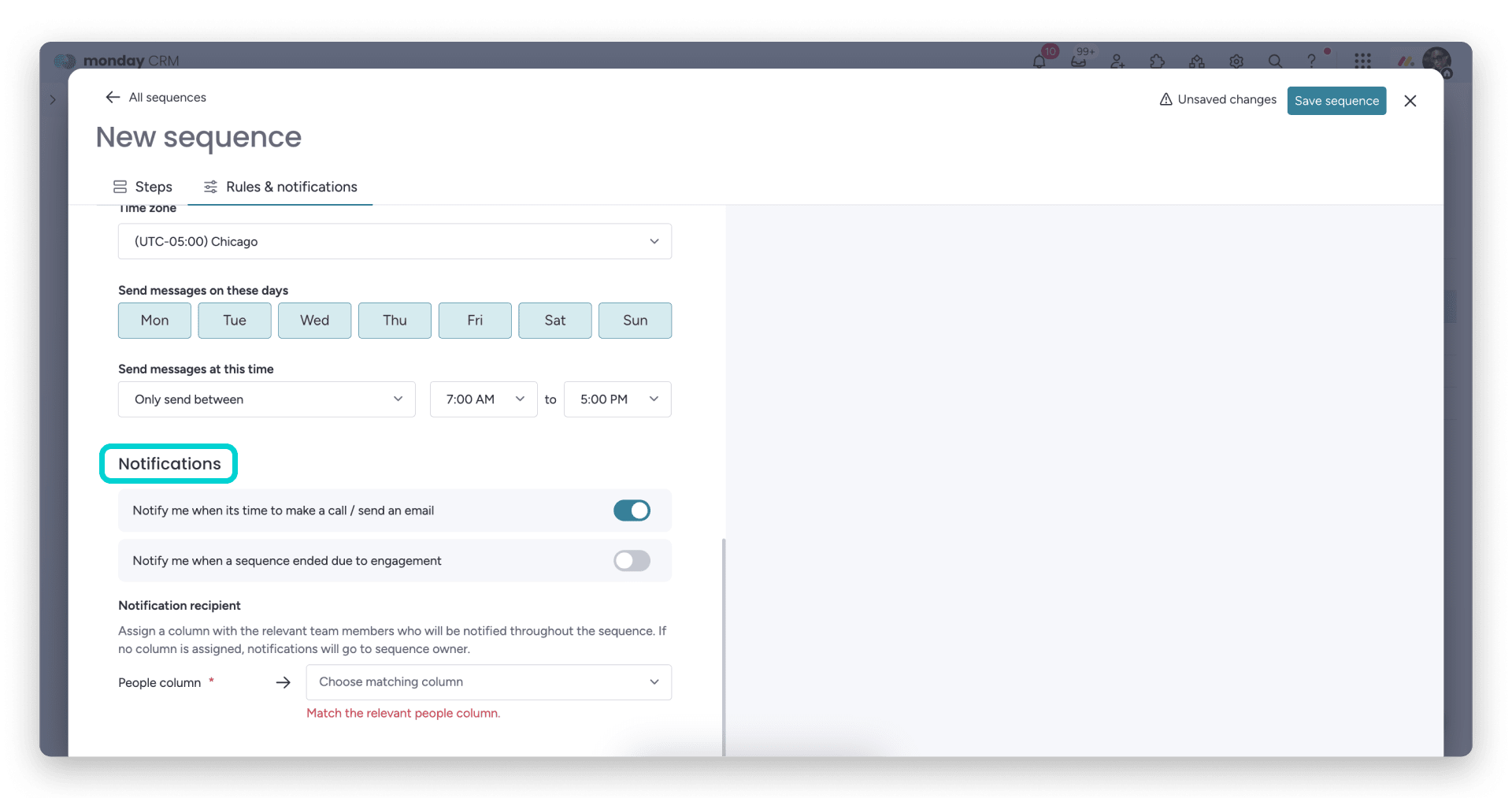
4. Activate and enroll leads into your sequence
Activate your sequence with a simple click in the sequence manager. You can then manually or automatically enroll leads into the sequence. To automatically enroll incoming leads and newly created contacts, you must create an automation with the Sequences app.
- Click Integrations at the top right of your board.
- Use the “When status changes to something, Enroll item in Sequence” template to automatically enroll leads or contacts in a specific Sequence. For example, you might use “When status changes to Interested” as the trigger. Every time a lead is marked as “Interested,” they’ll be enrolled in your designated sequence.
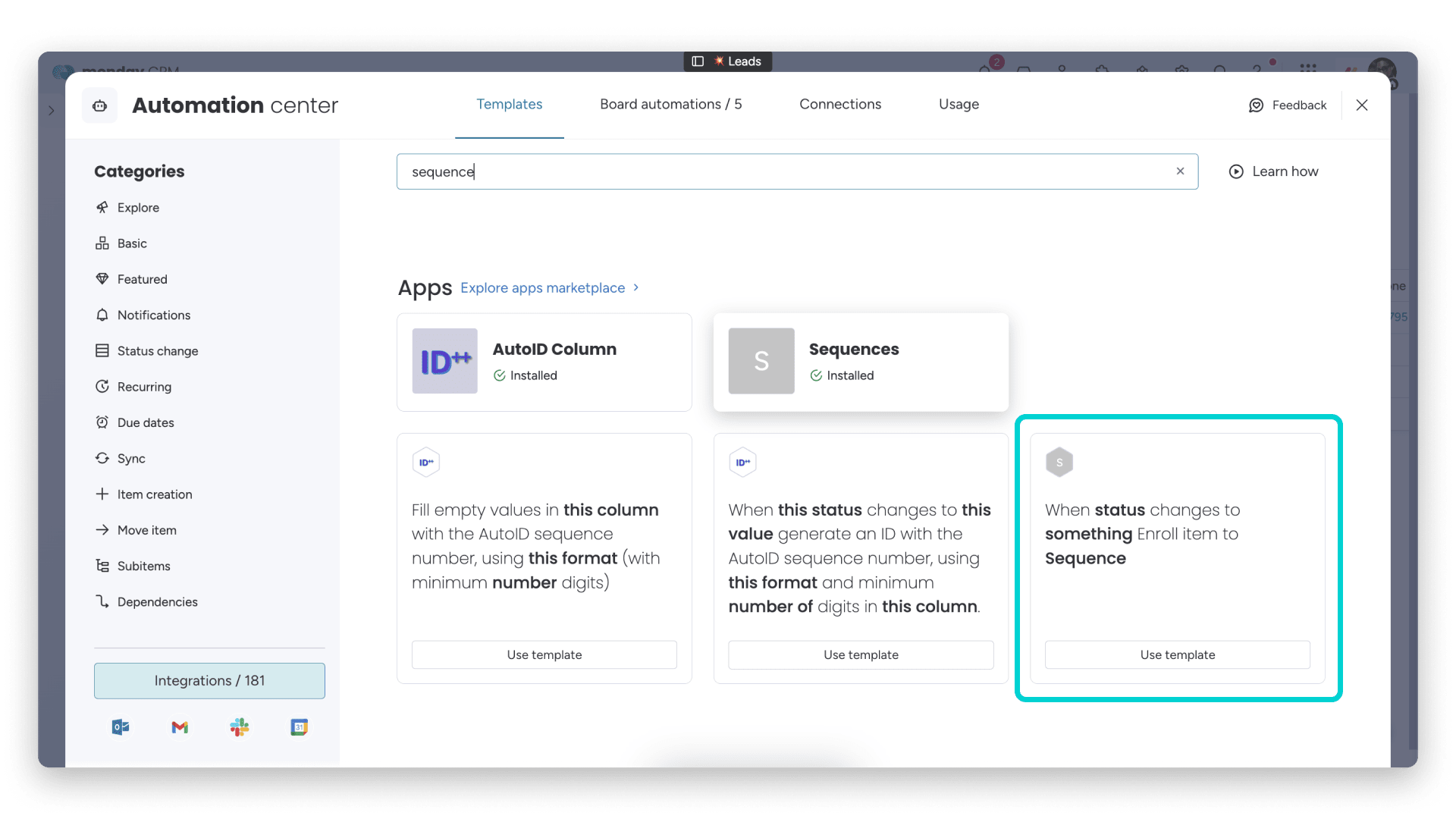
5. Track your sequence
The sequences feature makes it easy to stay on top of your sequences after they’ve been created. Use the “sequences manager” tab to track
- The status of the Sequence
- Total number of contacts enrolled in a Sequence
- How many are active
- How many have completed the Sequence
Use the Emails & Activities timeline to track progress via a timeline showing the steps completed. Sequences can still be edited after they’ve been completed.

Enhance customer relationships and boost revenue with automated, customized email sequences
Automated email sequences can save you time and money and help you scale your business. CRM software like monday CRM makes it simple to send timely, relevant, and personalized messages that nurture, engage, and convert leads into paying customers. With advanced features like integrations, automations, and analytic dashboards, monday CRM equips you with everything you need to manage your email campaigns from one place, sync leads & subscribers, and get notifications and stats on sent campaigns.
Plus, our email sequence templates, like the Email Marketing Template, include email design tools, built-in automation tools, custom audience creation, and many integrations with your favorite services. Try it yourself with a 14-day trial and see how easy it is to plan, execute, and monitor email sequences compared to traditional email marketing software.
Try monday CRMFAQs
What’s the difference between an email sequence and drip campaign?
Email sequences and drip campaigns are marketing automation email strategies, but drip campaigns are static, while email sequences are dynamic. Drip campaign emails are sent based on a single pre-defined trigger, and their course of action does not change based on customer behavior. This can include things like a weekly newsletter or an initial welcome email flow. Email sequences, on the other hand, change depending on a customer’s action. For example, the course of an email sequence will change depending on whether or not someone interacted with the previous email.
How long should an email sequence be?
There’s no fixed length for an email sequence. Determining factors for sales sequence length include:
-The buyer persona
-The buyer’s journey stage
-The desired outcome of the email sequence
-The average sales cycle length of your business
Generally though, email sequence ranges from 3 to 10 emails. Short sequences (less than 5 emails) are better for time-sensitive while longer sequences (more than 5 emails) are better suited for nurturing leads, or re-engaging inactive subscribers.
Why use email sequences?
Email sequences allow you to:
-Keep people engaged with your brand.
-Simultaneously save you time while making you money
-Automate marketing campaigns with personalized and relevant emails.
 Get started
Get started 

